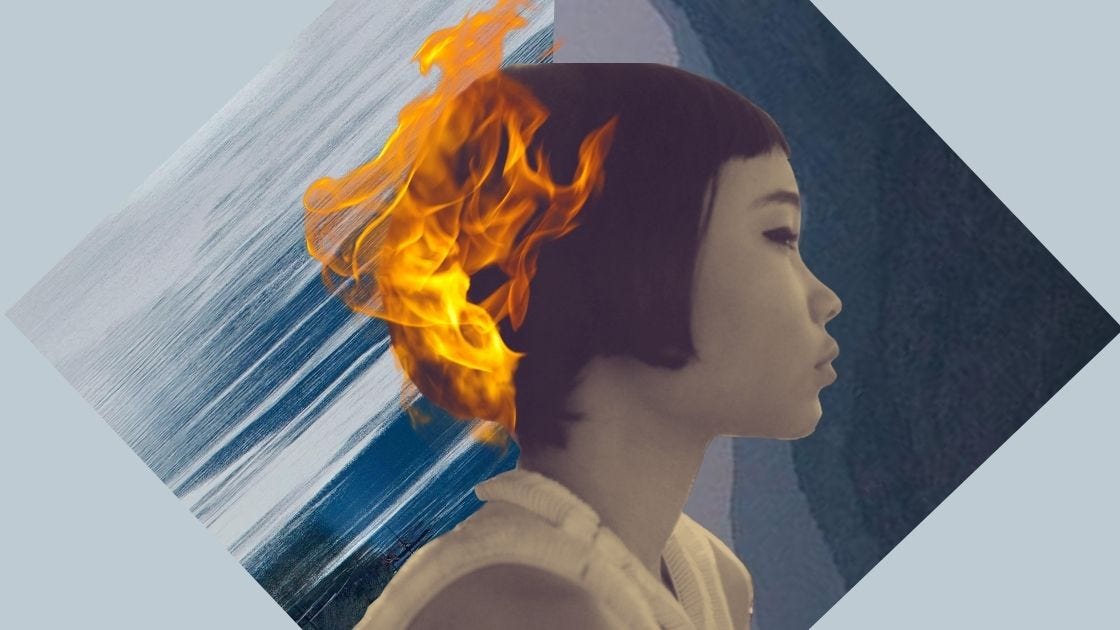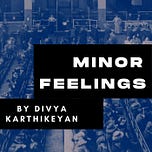
edited by Febin Mathew
Before I proceed, I want to write a note to all of you lovely readers out there. I cannot thank you for your support for the newsletter and the podcast. I was trying to find my footing and direction with this newsletter, (thank you for your patience) and realized the power of putting myself out there a little more, not too much, just about enough.
The podcast will now be embedded here in the newsletter, though still available on Spotify, iTunes, and Stitcher as always. Once again, thanks for taking a chance on Minor Feelings. Your support matters.
My therapist in Brooklyn asked me a question over Zoom that I will never forget, one that has rung in my ears with every little decision I’ve made since, despite her voice breaking up over awful wi-fi.
“Do you see yourself as an Indian woman or a woman of the world?”
I didn’t take much time to answer her. I said, quite self-assured,
“I’d say the latter. I feel like I’ve both grown up in a combo of caste, class and religious privilege, a relatively progressive family and a need to break through stereotypes that allows for societal constructs of our world not to touch me very deeply, or permeate my inner self.”
What I probably missed out on telling her, I later thought, was that I learnt over years that an insidious part of those societal constructs had given me the very misery I’ve fled from and never felt my way through. I learnt to suppress my rage and pain, and appear prim and proper because I watched anger and desire unfold in “difficult women” around me. I instantly associated that with something ugly. Beauty lies in harmony, I thought. I saw the women around me recite that story with a fervour, until they imploded one day.
I’m not alone, and this plagues women across the globe. To be seen is to appear well, and pretty; cancel out the noise in your head and replace it with reluctant quiet. Patriarchy, gender roles, toxic masculinity, systemic inequity, and rom-coms are important to factor in. But no matter how we try to disengage with these, it is literally impossible to divorce niceness and neatness from one's culture.
In this issue, I dug deeper into understanding Korean culture, which probably has one of the most rigid systems of finding acceptance and community as a woman (or man too) among most Asian cultures. Those who suffer from the cultural backlash are women in South and North Korea who are mostly of the lower socio-economic class. In the 1970s, Korean psychiatrists were stumped by a malady commonly referred to as hwa-byung, or ‘fire disease’. For this week’s episode and issue, I spoke to Dr. Jonghyun Lee, a researcher at Harvard University’s Korea Institute and an associate professor at Bridgewater State University, who’s authored many papers on the illness and works with Korean communities.
What is HWA-BYUNG?
Hwa-byung literally means illness (Byung) of fire or anger (Hwa) which arises when people are limited from confronting their feelings of anger and rage due to what is perceived as unfair circumstances.
Symptoms include feelings of chest discomfort, a sense of feeling choked, that something hot is coming up from the abdomen, combined with anxiety, despair, depression and anger. In 1983, a psychiatrist in the U.S. UCLA Medical Center suggested in his study that Hwa-byung might be a culture-bound syndrome, after treating three Korean-American women who thought they had the illness.
But he also mentioned there was no clear consensus as to whether the syndrome should be classified as culture-bound. "Hwa-byung could be universal.” Dr. Sung Kil Min of Seoul’s Yonsei University explained the somatic nature of it where the illness can "cause hurt, damaging, boiling, almost an exploding sensation inside the chest or body."
CONFUCIAN HARMONY AND THE MODERN WOMAN
“If a hen cries, the family dies out”.
That’s a pretty popular Korean proverb - the hen here denotes the subservient female head of a traditional family.
In the homes of Korea, Confucius rules even today. The Chinese philosopher is the father of Confucianism, where “our” is used instead of the word “my”. For example, our house, not my house, and our lover, not my lover in daily life, because harmony forms an essential tenet of the philosophy. Harmony, particularly within a family, is the predestined goal no matter what the cost.
But here’s where conflict drops by. With an increasing focus on the individual over what Confucius defined as harmony, personal agency has permeated Korean culture as the western world mingles with it. Individual freedom, independence and prosperity are essentially the backbone of the west, which Korea rejects.
Essentially, if you have a family of parents and children, it’s almost impossible to consider each other and themselves as separate individuals. The family is the origin of each person, valued over each member’s wants or needs.
Here’s where Hwa-byung incidences occur. In the Yin (male role) /Yang (female role) school of thought, women and men are assigned everything from who cleans the mess in the house to the establishment of their sexual identity and freedom. A sense of self or autonomy is foregone in this process. This is a hotbed for conflicts, be it in Korean culture or anywhere. Mother-in-law and daughter-in-law, husband and wife, husband/wife and children.
Take a closer look at an emotion and a need that drive women to feeling Hwa-byung - aggression or rage, and sexual urges. Confucians thought that the impulse to show rage or exhibit sexual desires doesn't concern others and denies morality in the larger society.
Being asked to lower their voice and suppress their anger for harmony in family is common, and becomes the basis for internalising conflict, that the problem is with them, not the world. So stuffing it in, building up, until one day, repression doesn’t lead to acting out rage or sexual rebellion. It leads to organ damage.
READ: That Other School Shooting, Richard Barnes for The New York Times
WISE MOTHER, GOOD WIFE
But how exactly does this manifest in this body from the mind? I mean, which body part? Korean folklore calls it the ‘gate of life,’ and the biological term for it is the epigastrium. This is the centre of Hwa-byung translating into bodily distress.
"A woman tries to suppress and accept it, but then she can't, so the suppression is never complete," Dr. Lee said. "[That] leads to a characteristic tight, stuffy feeling that consolidates into an epigastric 'mass.'"
When we talk about gender roles, the traditional Korean household requires women to have extensive and systematic knowledge on child rearing and homemaking. The WMGW (Wise Mother, Good Wife) tenet is often used, post industrialisation in Korea, to reinforce beliefs that a woman, no matter how qualified or how many ever institutions accept her for courses, those courses must have everything to do with keeping the home and children in order.
How do you cope in a situation like this, where wants and needs are at the bottom of the pile?
You don’t.
Women who endorse traditional family roles don’t really have coping mechanisms. Like active problem solving and willing to deal with and pursue confrontation. What instead is employed is avoidance, passive withdrawal, and accommodation of beliefs that are directly in conflict with their wants and needs.
Even Hwa-byung patients who have access to a psychologist have a polite attitude the moment they walk in which slowly and gradually morphs into a little pain, here and there, and eventually leads to an emotional and rage-filled outburst, often in clinics designated for the illness called Hwa-byung clinics.
WATCH:
Kim Ji-Young, Born 1982, a South Korean movie in 2019 that reignited tensions over gender roles and how women must and must not be. Based on a book written by Cho Nam-joo, a television scriptwriter, it tells her story from birth to motherhood from the perspective of her male psychiatrist. You can also get the novel here.
KOREA IN AMERICA
In the US, Korean immigrants aren’t off to a great start, just like many POC communities that immigrate. Lee says limited English proficiency can limit them to low-paying jobs despite having excellent credentials from back home.
But here’s where the gender role dynamic from Korea translates into a far more complicated situation for Korean immigrant women, because they need to hold paying jobs as well as take care of home. This tends to give them a sense of autonomy, on the bright side. On the flip side, it challenges the notion back home of traditional patriarchy, which never really leaves them, particularly while mingling and remaining in ethnic communities.
Dr. Lee noted in his fieldwork of interviewing women in South Korea and comparing his notes with interviews of Korean immigrants in the US, that the former had a rate of 5% of Hwa-byung incidence, while the latter had a rate of 12%. He says a lot of it has to do with honesty and community.
Women in Korea talk to each other, and inform each other of symptoms of Hwa-byung and seek help, however quietly and without a fuss. In contrast, Korean immigrants in the US feel a constant need to prove themselves in a new country, and believe in a loss of face if they talk to their close-knit communities that face an identity crisis of their own.
But contrary to the general idea that Confucian ideas of family harmony are embedded in toxic beliefs, maintaining that harmony in an immigrant household can actually help, because family’s really all you got when you’re in a new country. The insidiousness of Hwa-byung lies in the pressure of navigating economic hardships, in making it big in America.
But how do we deal with both without altering the backbone of Korean culture that is Confucian philosophy? The patriarchal ideology and the economic hardships that cause the buildup - how do we address that without a cultural overhaul? Dr. Lee explores English proficiency classes and vocational training as a possible stop-gap. Also, creating programs for couples and their children can help Korean immigrant women overcome their struggle with hwa-byung symptoms.
LISTEN:
“Twenty-three,” by K-pop star IU, in which she sings about the pressure on women to appear child-like at all times, however older she gets. Pretty radical in K-pop.
As women from any culture out there, we’ve learnt to shapeshift our ways through life’s roles, even when we get more than what we thought we had signed up for. That said, just like our lives can’t be defined simply by a single role, Korean culture and philosophy comprise multiple philosophical underpinnings. A mix of Taoism, Buddhism and Confucianism pervade the way Korean society functions, and this culture is not entirely defined or dictated by the Confucianism explored in this story. Just as the Han (fire) in Hwa-byung manifests differently in Korea and America, women across the world contain multitudes and evolve with time.
Thanks for reading, and see you next fortnight.







Share this post